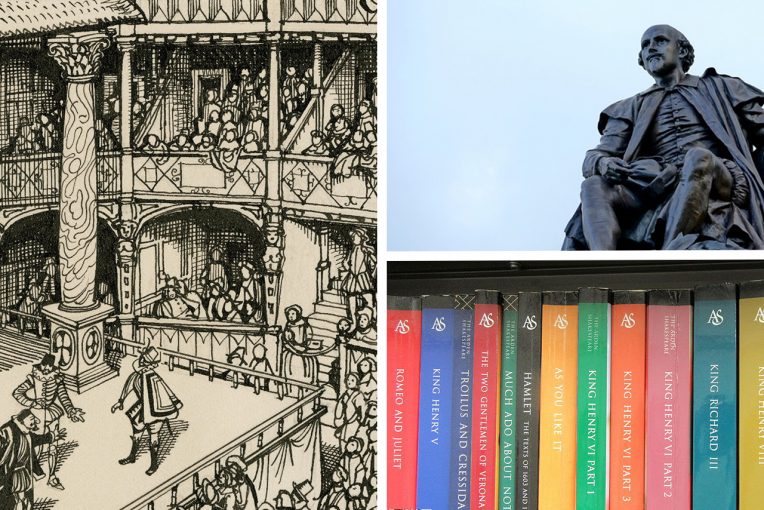In Jane Austen’s Sense and Sensibility, characters occasionally talk about “the picturesque” in relation to natural landscapes and painting. The most detailed account appears in chapter 18 of the novel, which director Quetta Carpenter also includes in her stage adaptation for ISF. Edward Ferrars visits the Dashwoods at their new home at Barton Cottage, where he rehashes a previous debate about the picturesque with Marianne. In the adaptation, Edward says:
“I shall offend you by my ignorance and want of taste if we come to particulars. I shall call hills steep, which ought to be bold; surfaces strange and uncouth, which ought to be irregular and rugged. You must be satisfied with such admiration as I can honestly give. I call it very fine country. It unites beauty with utility. But I know nothing of the picturesque.”
Ferrars is simply talking about the natural sights on his way to Barton, but he stumbles and frets over precise language as if he is a critic trying to describe a work of art. That is at the heart of the concept of the picturesque, which refers to landscapes deemed fit to be the subject of a painting—specifically the works of seventeenth-century painters such as Claude Lorrain. Ferrars anticipates Marianne’s disapproval of his “ignorance” and “want of taste,” remembering that she had made fun of his undeveloped aesthetic eye in an earlier meeting. Ferrars’ speech suggests that the picturesque served as a kind of measuring stick that set truly “cultivated” minds apart from everyone else—at least to opinionated individuals like Marianne.
The picturesque is an important element in Sense and Sensibility because it helps us understand the different values and inclinations of various characters, which might impact how compatible—socially or romantically—they are with one another. In Marianne’s case, she cannot imagine loving anyone who does not have a deep and thorough appreciation of the picturesque, alongside the poetry of William Cowper and the ethos of sensibility (which I will return to later).
But what exactly does the picturesque entail? And how did this aesthetic concept develop in British society?
The idea of the picturesque developed throughout the eighteenth century, popularized by the writings of William Gilpin, Richard Payne Knight, and Uvedale Price. Gilpin in particular published treatises and created artworks that set the standard for what qualifies as a picturesque landscape. He traveled extensively throughout England, Scotland, and Wales, identifying the picturesque in local settings. This led to a tourism fad in the 1780s and 1790s, as well as shifting landscaping styles away from the artificial gardens of continental Europe to techniques that preserve the English rural countryside.
Austen was quite familiar with Gilpin’s theory, and some of her characters’ descriptions of landscapes borrow heavily from his essays. As Ferrars notes in the speech above, Gilpin praised complex, irregular scenes that have a strikingly rugged feel. Ferrars goes on to tell Marianne: “I like a fine prospect, but not on picturesque principles. I do not like crooked, twisted, blasted trees. I do not like ruined, tattered cottages. I am not fond of nettles or thistles, or heath blossoms.” Ferrars’ list includes the same things that Gilpin praised in his essays. So, even though Ferrars protests that he knows nothing of the picturesque, he turns out to be quite well-informed.
Moreover, Gilpin argued that picturesque landscapes could evoke powerful emotional responses. Uvedale Price further developed this theory, proposing the picturesque as a third aesthetic category that sits between Edmund Burke’s famous distinction between the beautiful and the sublime. If the beautiful was serene and delightful while the sublime stirred awe and terror in the viewer, the picturesque could walk the line between these two extremes, finding pleasure in disorderly sights. This emotional experience of the picturesque is key to understanding Austen’s own evocative descriptions of landscapes, as well as accounts of the pleasure that her characters feel when basking in nature’s glory. In Sense and Sensibility, Marianne is especially attuned to nature. She cries murder when she hears that the mulberry trees at Norland, her childhood home, are dying due to inattention. She also laments that no one there has the capacity to admire the falling autumn leaves.
The popularity of the picturesque coincided with the so-called “cult of sensibility” that Austen alludes to in the novel’s title. Reaching its height in the late 18th century but already in decline by the time that Sense and Sensibility was published, adherents to the ethos of sensibility put feelings and intuition above reason and social norms. They believed that the heart is the greatest moral compass, sometimes even at the expense of common sense. Marianne, of course, believes wholeheartedly in this idea—which gets her into trouble.
But while Marianne is the most prominent advocate of the picturesque and sensibility, she is not the only one in the story who considers these ideas. In fleeing moments, other characters are moved by a beautiful sight or artwork or let their heart guide their actions. Even characters who seem to lack the capacity for true feeling comment on the picturesque, knowing that it is seen by many in high society as a sign of “good breeding.” And even Ferrars, who does not understand all the fuss about the picturesque, still recognizes an arresting landscape when he sees one.
Be sure to pay attention to which characters bring up the picturesque when you see Sense and Sensibility this summer at ISF. And the next time you come across an arresting landscape (perhaps at the grounds at Ewing Cultural Center), ask yourself if it meets these criteria.




